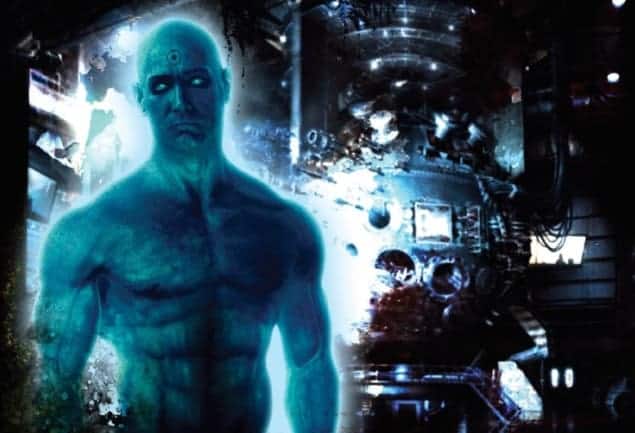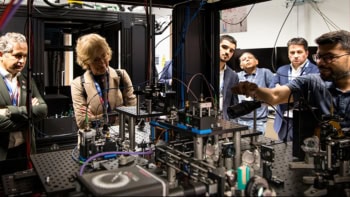The Amazing Story of Quantum Mechanics: a Math-Free Exploration of the Science that Made Our World
James Kakalios
2010 Gerald Duckworth & Co Ltd/Gotham £12.00pb/$26.00hb 336pp

Have you ever wondered what happened to all the flying cars and personal ray guns we were promised? Anyone who has watched TV, gone to the cinema or read science fiction knows that by now we should inhabit a world full of amazing devices. And actually, we do: the problem is that when we look around, we see that the amazing devices we ended up with are mostly not the ones that science fiction predicted. So what happened? Why did we get mobile phones and the Internet instead of jet packs and teleporter systems?
James Kakalios’ book The Amazing Story of Quantum Mechanics starts out with various versions of this same question, and proceeds to make the case that quantum mechanics is responsible for most of the really cool devices we take for granted (and that a lack of breakthroughs in energy technology accounts for the missing jet packs and other gadgets). By exploring these unforeseen consequences of the quantum revolution, Kakalios sets out to accomplish two basic goals: explaining the theory of quantum mechanics to non-experts, and showing how this theory has given us cool stuff.
Given these goals, one thing that is particularly enjoyable about the book is that it is not yet another history of quantum mechanics. Explaining quantum mechanics for the non-specialist, without mathematics, is generally a daunting challenge, and a lot of writers seem to shy away from it by getting very philosophical or very historical very quickly. By basing his book on the science behind real devices, Kakalios is able to focus instead on the practical aspects of quantum theory.
Early in the book, Kakalios presents the reader with three “impossible ideas”. Briefly, they are: (1) light is composed of discrete packets; (2) matter exhibits wave properties; and (3) everything has intrinsic angular momentum. The expert will quickly recognize these ideas, and appreciate that they are not the standard starting point for presenting quantum mechanics in courses and textbooks. However, this is a good thing because these ideas have a closer connection with everyday experience and get directly to the issues relevant for technology. Too often, standard approaches focus initially on the wavefunction and its weirdness, but this does not readily lend itself to everyday analogies.
Another aspect of the book that makes it attractive to non-specialists is that essentially every quantum-mechanical idea is connected with a character or story from science fiction or superhero lore. Indeed, most chapters start with such stories, which provide unusual context for the topic at hand. For example, a section on wavefunctions begins with a story from the graphic novel Watchmen by Alan Moore, in which atomic physicist Jon Osterman is transformed into the superhero Dr Manhattan when experiments on the four fundamental forces of nature go spectacularly wrong. By asking why these experiments turned Osterman’s skin blue, or what it means for him to “gain control” over his quantum-mechanical wavefunction, Kakalios gets a unique starting point for addressing some rather abstract and challenging physics. And, of course, the real heroes of the development of quantum mechanics – the physicists and chemists who are in all the textbooks – also get their due.
Through this mixture of fiction and reality, the reader learns how the three impossible ideas of quantum mechanics were discovered, and what they really mean for the fundamental behaviour of matter. There is, however, one occasional drawback to starting each chapter with a fictional story.
For Kakalios, a physicist at the University of Minnesota who has previously written a book called The Physics of Superheroes, the distinction between science and science fiction is clear and obvious. However, readers who are less familiar with either the real history of science or the characters of science fiction may initially wonder whether the person being discussed is real or fictional. This is always made clear later in the chapter, but at first it can be disconcerting.
Another weakness of the book is that although Kakalios does a great job of handling the “impossible” ideas of quantum mechanics, he does seem to assume that the reader is already familiar with energy in the same way physicists are. Admittedly, the ideas of energy conservation are addressed to some degree, but a non-specialist could run into difficulties when their everyday views of energy fall short of the physics view of energy. In my experience of teaching physics to non-specialists, this difference between the common usages of the word “energy” and the specific physics concept is one of the biggest challenges students face. In everyday usage, energy is often viewed as an independent thing, such as an “energy field” or an “energy beam”. In physics (and in the applications in this book), energy is a property of things and it can come in many forms.
As we journey with Kakalios through the three impossible ideas of quantum mechanics, he provides the reader with a number of powerful analogies. Perhaps the most important analogy in the later chapters concerns the electron band structure in solids, which comes up because the devices that interest Kakalios are all grounded in solid-state physics. Explaining how they work therefore requires him to address the electronic behaviour of materials. To do this, he suggests we imagine the electrons in a theatre, complete with orchestra, balcony and mezzanine seating. As we explore the impact of filling or not filling the orchestra, and jumping between the different seating options, we learn how materials gain their all-important electronic properties and what this means for technology. The use of the theatre analogy is perhaps the strongest element in the book. Having used it to build a mental picture of the world of electrons, Amazing Story concludes with explanations of the inner workings of many modern devices, from transistors to LEDs and MRI.
Overall, the book accomplishes its goals. By focusing on concrete applications, real-world devices and the sometimes fantastical vision of science fiction, the abstract world of quantum mechanics is made accessible to the non-specialist. As a bonus, we learn how quantum mechanics actually did make possible some of the powers and devices envisioned in early- to mid-20th century science fiction – and, even more importantly, how it gave us a whole host of unforeseen wonders.



